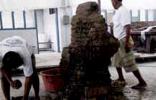Basic HTML Version



สาขางานช่
างฝี
มื
อดั้
งเดิ
ม
มรดกภู
มิ
ปั
ญญาทางวั
ฒนธรรม
52
T
he model making and casting of the Buddha
statue
are classified in Thailand’s Chang Sip Mu
(Ten art and craft categories). It belongs to the casting
category, and it also involves model making--which
is classified in the sculpture category. The two processes
are related because a model or a sculpture must be
made before the casting process can begin.
The Thai traditional methods of model making and
lost-wax casting of the Buddha statue are as follows:
Model making
- The model making starts from
making the core of the model, which is made of sand
and clay mixture. The next step is to make V-shaped
channels - the main one with its branches - for pouring
in the molten metal to replace the wax. A layer of
Din Mom or clay mix - a mixture of ash, clay, and
water - is then applied to coat the core and
strengthen it. This is followed by the Tha Thueak
process whereby a coat of vi scous l iquid -
amixture of beeswax
and thick rubber oil
is applied. Finally,
wax is applied in the
Khao Khi Phueng or
wax coat process,
wh i c h i n v o l v e s
forming the wax
coat that will serve
as the original model and will look exactly like
the desired cast. This wax sculpture is modeled in
fine details and chased. It will become the mold cavity
to be filled with the molten metal.
Moldmaking
-Theprocessbeginswiththeapplication
of Din Nuan (clay mixed with cow dung and water)
on the wax figure. Three coats are required and
each time the coat must be left to dry thoroughly
before applying the next coat. Metal pins are
then inserted through to the core model in order
to stabilize the mold cavity. Vents are attached
for wax removal. Din On - Din Nuan mixed with
fine-grained sand and water - is applied to coat the
figure which has been fixed with pins and vents for
wax to pour out. This forms the first layer, which is
The Buddha Statue Model Making and Casting
coated over with a slightly thicker layer of Din Kae -
a mixture of clay, fine grained sand and water
to form the second layer of coat. Metal wires
are then strapped in a mesh-l ike fashion to
protect the mold from the pressure that will
build up inside when the mold is heated, which
might crack and break the mold. The second layer
of Din Kae is
then appl ied
to cover the
wire strapping
and the mold
is left to dry for
four to seven
days. Then Pak
Chok (pouring cups or pouring basins) and Ru Phut
(vents for gas generated during the pour) are made.
LostWaxor Investment Casting
- Theprocess begins
with Lom Hun or moving the mold to the area where
metal pouring will take place and followed by Khuen
Thon or flipping the mold. Scaffolding is constructed
and a channel for receiving the melting wax is
fixed in place. The mold is then heated to remove
the wax. The metal is melted in a crucible and poured
into the mold cavity.
When t he me t a l
c oo l s down a nd
solidifies, the mold
i s des t r oyed and
the wi re strapping
i s r emoved . The
metal figure is chased
and blackened or
applied with lacquer coat and gilded.
The Thai traditional method of model making
and casting of the Buddha statue reflects the folk
know-how in appropriately selecting the local
materials and the unique method of casting hollow
sculptures with fine, thin shell. The Buddha statue
model making and casting is therefore considered
a hi ghly valued rel i g ious ar t and craf t and
has contributed to perpetuation of Buddhism
in Thailand.

